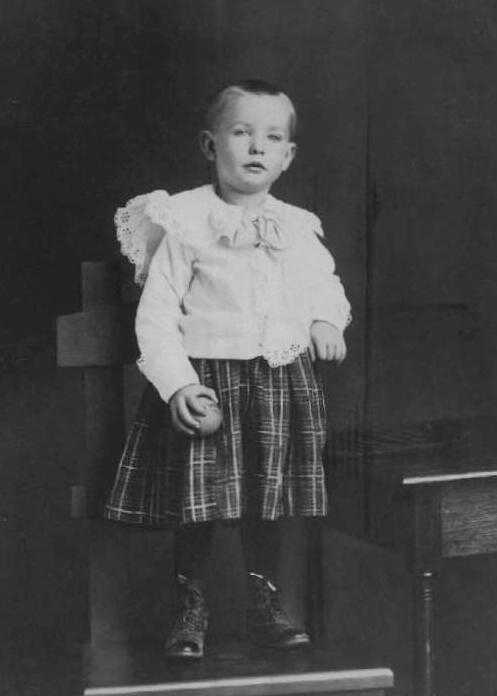
Blouse Construction

Figure 1.--This Amwrican boy wears a fancy blouses with a kilt skirt. This was prbably his formal Summer outfit. The portrait is undated, but we would guess was taken about 1895. While the clothing is dated, note how modern the hair style looks, quite in style for 2004. Also note how the blouse bloses over the waistline of kilt skirt.
|
Blouses were constructed differently than shirts. The primary difference is that there are no shirt tails. Modern blouses, for examplw, are shirts without tails. Turn of the 20th century blouses. often called waists, were a little different. They came equipped with a drawstring at the waistline. The drawstring was drawn and tied giving a kind of bloucing affect that can be seen in many turn-of-the century portaits. Bloucing means according to 'Webster's Dictionary means "to pull out in drooping fullness". This is a good example of the American tendncy to create verbs out of nouns. This is an important difference between American and English English. The English in recent years have adopted so much American English that the term may now be used in England as well.
Lack of Shirt Tails
Blouses were constructed differently than shirts. The primary difference is that there are no shirt tails. Modern blouses, for examplw, are shirts without tails.
Drawstrings
Turn of the 20th century blouses. often called waists, were a little different. They came equipped with a drawstring at the waistline. We notice that Webster's Dictuonary used the term "blouseon" which appeared about 1900-05. It refers to a blouse with a waist drawstring. We have not yet noticed it being used in the ads for boys' waists at the time. e do notice these drawstring blouses being referred to as "waists". A good examples are Sears 1896 blouses.
Blousing
The drawstring was drawn and tied giving a kind of bloucing affect that can be seen in many turn-of-the century portaits. Bloucing means according to 'Webster's Dictionary means "to pull out in drooping fullness". This is a good example of the American tendncy to create verbs out of nouns. This is an important difference between American and English English. The English in recent years have adopted so much American English that the term may now be used in England as well.
We understand how drawstring blouses worked. We are not sure given the fact that boys wete likely to be playing and running about,why the blouses even with the drawstrings tied would not gradually fall down. A reader writes, "I think I understand what is meant with a drawstring and how the blose bloused over the waistline. But how did they prevent this drawstring from gradually falling down? Please see the attached drawing.
Blouses were also made in the button-on style. We are not sure about the chronology here. We know this style began was being worn in the 1910s, but it presumably appeared earlier. The drawstring blouses with a pronounced blouceing affect seem more popular at the turn of the 20th century. The buttob-on style became more popular in the 1920s. We note sets appearing. Early sets look more like one-piece suits because the bloce and pants seem to be made out of the same material.
Modern Blouses
The button-on style is now less common. It can still be found in expensive botique clothing. Other blouses were made simply as shirts without tails. Pants were held up by wearing suspended pants like the suspender shorts wirn with Eton suits or shortalls.
HBC

Navigate the Boys' Historical Clothing Web Site:
[Return to the Main blouse page]
[Introduction]
[Activities]
[Biographies]
[Chronology]
[Cloth and textiles]
[Clothing styles]
[Countries]
[Topics]
[Bibliographies]
[Contributions]
[FAQs]
[Glossaries]
Images
[Satellite sites]
[Tools]
[Boys' Clothing Home]
Created: 10:36 PM 2/7/2005
Last updated: 12:17 PM 6/18/2006



